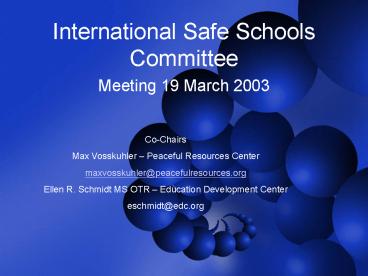International Safe Schools Committee - PowerPoint PPT Presentation
1 / 10
Title:
International Safe Schools Committee
Description:
International Safe Schools Committee. Meeting 19 March 2003. Co-Chairs ... Your opinions to improve our work to moa.sundstrom_at_phs.ki.se or leif.svanstrom_at_phs.ki.se ... – PowerPoint PPT presentation
Number of Views:34
Avg rating:3.0/5.0
Title: International Safe Schools Committee
1
International Safe Schools Committee
- Meeting 19 March 2003
Co-Chairs Max Vosskuhler Peaceful Resources
Center maxvosskuhler_at_peacefulresources.org Ellen
R. Schmidt MS OTR Education Development
Center eschmidt_at_edc.org
2
AGENDA
- Brief History of ISS
- Review of Documents
- Indicators for Safe Schools
- Matrix
- Tiers of Designation
- Logo
- Infrastructure
- Future
- Official Launch of Designation Model
- Conferences
3
HISTORY of ISS
- May 2001 Safe Comm 10 Discussion Break-out
meeting resulted in International Safe Schools
Committee - 2001 2002 Small nucleus of committee
investigated - needs of schools vs. larger communities
- viability and importance of ISS
- drafted school version of indicators for
Montreal - drafted concept of matrix for Montreal meeting
4
History Continued
- May 2002 Safe Comm 11 6th World Conf on Injury
Prevention and Control - Schools issues have permanent place in Safe
Community Movement - Committee Vastly Expanded
- 2002 Present Committee finalizes for
presentation to Safe Comm Movement - Indicators
- Matrix
- Tiered Designation Process
- Logo
5
Safe Schools Indicators as of 18 Mar 2003
Safe Schools in a Safe Community setting
have 1. 1. An infrastructure based on
partnership and collaborations, governed by a
group of teachers, pupils, technical staff and
parents that is responsible for safety promotion
in their school the group should be chaired by a
School Board representative, with the Headmaster
as a co-chair 2. 2. Safe School policies
decided by the School Board and the Community
Council in a Safe Community setting 3. 3.
Long-term, sustainable, operational school
programs covering both genders and all ages,
environments, and situations 4. 4. Programs
that target high-risk groups and environments,
and programs that promote safety for vulnerable
groups 5. 5. Programs that document the
frequency and causes of injuries both
un-intentional (accidents) and intentional
(violence and self-directed) 6. 6. Evaluation
measures to assess school policies, programs,
processes and the effects of change 7. 7.
Ongoing participation in Safe Schools networks
at community, national and international
levels. These indicators have been developed by
the International Safe Communities movement with
the objective to make the World a better and
safer place to live, work and play in. Please
read more about us on www.phs.ki.se/csp and give
us Your opinions to improve our work to
moa.sundstrom_at_phs.ki.se or leif.svanstrom_at_phs.ki.s
e Specifically for Safe Schools issues contact
maxvosskuhler_at_peacefulresources.org or
eschmidt_at_edc.org, co-chairs.
6
Matrix
7
Pyramid
- Tiered to recognize progress
- Encourages Participation in change processes
- Peer to peer evaluation and sharing are
fundamental
8
LOGO
9
FUTURE
- Take Matrix and Create open ended yet concrete
suggestions for Communities and Schools to follow
to become safer - Work on inclusion of Safe Universities and Other
more specialized education Institutions. - Launch Designations
10
Infrastructure
- Database of registry
- Local/Regional Expertise from committee
- Funding Mechanisms
- Committee forms Advisory Board to legal entity of
Peaceful Resources Center - Peaceful Resources Center Seeks formal
designation as Affiliate Center of WHO CC for
Community Safety Promotion































